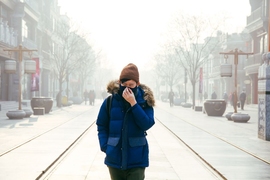The Covid-19 pandemic has been depressing, demoralizing, and stressful for people around the world. But is there any way to measure exactly how bad it has made everyone feel?
A new study led by MIT researchers attempts just that, through a massive examination of hundreds of millions social media posts in about 100 countries. The research, which analyzes the language terms used in social media, finds a pronounced drop in positive public sentiment after the pandemic set in during early 2020 — with a subsequent, incremental, halting return to prepandemic status.
To put that downturn in perspective, consider a prepandemic fact that the same kind of analysis uncovered: Typically, people express the most upbeat emotions on social media on weekends, and the most negative ones on Monday. Worldwide, the onset of the pandemic induced a negative turn in sentiment 4.7 times as large as the traditional weekend-Monday gap. Thus the early pandemic months were like a really, really bad Monday, on aggregate, globally, for social media users.
“The takeaway here is that the pandemic itself caused a huge emotional toll, four to five times the variation in sentiment observed in a normal week,” says Siqi Zheng, an MIT professor and co-author of a new paper detailing the study’s results.
The paper, “Global evidence of expressed sentiment alterations during the Covid-19 pandemic,” appears today in Nature Human Behaviour.
The authors are Jianghao Wang, an associate professor at the Institute of Geographic Sciences and Natural Resources Research, Chinese Academy of Science, in Beijing; Yichun Fan, a PhD candidate in MIT’s Department of Urban Studies and Planning (DUSP) and the Sustainable Urbanization Lab (SUL); Juan Palacios, a postdoc at the MIT Center for Real Estate and SUL; Yuchen Chai, a researcher at DUSP and SUL; Nicolas Guetta-Jeanrenaud, a graduate student in the MIT Technology and Policy Program (TPP); Nick Obradovich, a senior research scientist at the Max Planck Institute for Human Development in the Center for Humans and Machines; Chenghu Zhou; and Zheng, who is the Samuel Tak Lee Champion Professor of Urban and Real Estate Sustainability at MIT and faculty director of the MIT Center for Real Estate and SUL.
To conduct the study, the researchers examined 654 million location-identified social media posts from Twitter in about 100 countries. The posts appeared between Jan. 1, 2020, and May 31, 2020, an early phase of the global pandemic.
The researchers used natural-language processing software to evaluate the content of the social media, and examined the language of pandemic-period posts in relation to historical norms. Having previously studied the effects of pollution, extreme weather, and natural disasters on public sentiment, they found that the pandemic produced bigger changes in mood than those other circumstances.
“The reaction to the pandemic was also three to four times the change in response to extreme temperatures,” Fan observes. “The pandemic shock is even larger than the days when there is a hurricane in a region.”
The biggest drops in sentiment occurred in Australia, Spain, the United Kingdom, and Colombia. The countries least affected by the pandemic in these terms were Bahrain, Botswana, Greece, Oman, and Tunisia.
The study also revealed a potentially surprising fact about temporary lockdown policies — namely, that lockdowns did not appear to have much of an effect on the public mood.
“You can’t expect lockdowns to have the same effect on every country, and the distribution of responses is quite wide,” says Fan. “But we found the responses actually largely centered around a very small positive reaction [to lockdowns]. … It’s definitely not the overwhelmingly negative impact on people that might be expected.”
As to why people might have reacted like this, Zheng says, “On the one hand, lockdown policies might make people feel secure, and not as scared. On the other hand, in a lockdown when you cannot have social activities, it’s another emotional stress. The impact of lockdown policies perhaps runs in two directions.”
Because many factors might concurrently affect public sentiment during a lockdown, the researchers compared the mood of countries during lockdowns to those with similar characteristics that simultaneously did not enact the same policies.
The scholars also evaluated patterns of sentiment recovery during the early 2020 period, finding that some countries took as long as 29 days to erase half of the dropoff in sentiment they experienced; 18 percent of countries did not recover to their prepandemic sentiment level.
The new paper is part of the Global Sentiment project in Zheng’s Sustainable Urbanization Lab, which studies public sentiment as expressed through social media, rather than public-opinion polling.
“The traditional approach is to use surveys to measure well-being or happiness,” Zheng observes. “But a survey has smaller sample size and low frequency. This a real-time measure of people’s sentiment.”
The MIT researchers were supported in part by the Massachusetts Consortium on Pathogen Readiness; support for the other researchers was in part provided by the National Science Foundation of China and the Youth Innovation Promotion Association of the Chinese Academy of Sciences.










